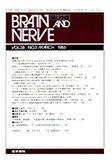Japanese
English
- 有料閲覧
- Abstract 文献概要
- 1ページ目 Look Inside
抄録 Recombinant interleukin 2(rlL−2)によって活性化されたlymphokine-activated killer (LAK)細胞が,グリオーマ患者より誘導できるかどうか,更には当教室で樹立したグリオーマ(ONS−12.−20,−44)細胞に対し,抗腫瘍効果があるかどうか調べた。グリオーマ患者の末梢リンパ球を,10単位/mlのrlL−2を含むcomplete medium中で72〜96時間培養した細胞をLAK細胞とし,以下の実験に用いた。標的細胞を51Crでラベルし,LAK細胞の細胞障害能は,4時間の51Cr release assayで調べた。IFNγ産生能は,PII Testに準じ,培養上清中に分泌するIFNγを測定した。自己のグリオーマ細胞に対するLAK活性は,約30%であり,自己のリンパ球より誘導したPHA blastsには,全く殺作用を示さなかった。更にallogeneicなグリオーマに対するLAK活性は,健常人の50〜70%であった。LAK細胞は,OKT−3(+).OK−8(+)であり,NK細胞群を一部含んだT細胞群と推測された。PII TestによるIFNγ産生能は,かなり早期より障害されていることが示唆されたが,LAK活性は,かなり末期の患者からも誘導可能であった。以上LAK細胞は,容易に大量に誘導することが可能でありadoptive immunotherapyに有用であることが示唆された。
We studied whether lymphokine-activated killer (LAK) cells were capable of being induced in vitro from peripheral blood lymphocytes (PBL) of patients with malignant glioma, by using recom-binant IL-2 (rIL-2). We then investigated whether they possessed anti-tumor efficacy against malig-nant gliomas (ONS-12, -20, -44). Human LAK cells were generated by placing 5 × 106 PBL into each well of 24-well plates (Corning) containing 2 m/ of complete medium (CM) with 10 units of rIL-2 (TGP-3, provided by TAKEDA Chemical Industries, Ltd.). The CM consisted of RPMI 1640 with O.1 mM nonessential amino acids, 1 μM sodium pyruvate, 5× 10-5M 2-mercaptoethanol, 50 μg/ml gentamicin sulfate, 0.03 % glutamine and 1% heat-inactivated human AB serum. The plates were incubated horizontally at 37゚C in a 5% CO2 atmosphere for 72~96 hours. The LAK cells were then harvested, washed three times with Hanks balanced solution, and resuspended in RPMI 1640 with 1% heat-inactivated human AB serum for the in vitro cytotoxicity assays. The anti-tumor cytotoxic activity of LAK cells was estimated in triplicate by 4-hr 51Cr release assays. The cytotoxic activity of the LAK cells against autogeneic ONS-44 glioma cells and PHA blasts was approximately 30% and a few %, respectively. The Natural Killer (NK) activity of the patient with ONS-44 glioma cells was equivalent to that of healthy subject. The in vitro cytotoxicity of LAK cells induced from lymphocytes of patients with malignant glioma against allogeneic ONS-12 and ONS-20 glioma cells was 50.70 % of the cytotoxicity of LAK cells induced from lymphocytes of healthy subjects. But these LAK cells didn't lyse the PHA blasts of each patient. Thus, LAK cells have apparent tumor specificity in vitro and are able to be easily generated. The cell surface phenotypes of the LAK cells was OKT-3+ and OKT-8+. When LAK cells generated by rIL-2 were pretreated with monoclonal Leu-7 antibody and rabbit com-plement, the anti-tumor efficacy decreased some-what. Therefore, the LAK cells consisted of Tcells, containing some NK cells. Then, using the PII (peripheral blood lymphocyte interferon in-duction) test, we studied gamma interferon (IFN-γ) production in patients with malignant glioma. The IFN-γ production induced by rIL-2 in healthy subjects and patients with malignant glioma was 344±108 and less than 40 units/ml, respectively. This suggested that the IFN-γ production bypatients with malignant glioma was impaired at a relatively early stage of disease. But the anti-tumor cytotoxic activity of LAK cells was capable of being induced from PBL of patients in the advanced stage of disease. These findings provide a rationale for clinical trials on the adoptive transfer of human LAK cells aenerated with rIL-2.

Copyright © 1986, Igaku-Shoin Ltd. All rights reserved.


